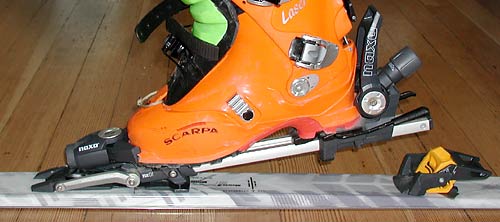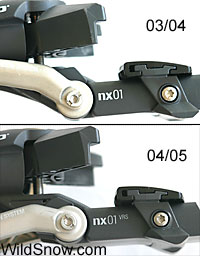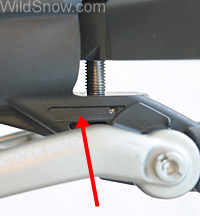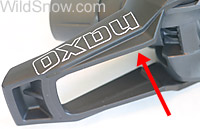
Naxo binding in touring mode, showing double toe pivot at first stage of stride.
Naxo backcountry ski bindings burst on the North American rando scene last winter with great expectation. They appeared as a terrific solution for skiers needing a “one rig” binding that allowed them to use the same skis at the resort and in the backcountry. The Naxo lived up to its promise for many skiers, but it had a few bugs. Most importantly, durability problems were too prevalent, and smaller skiers sometimes had problems with their boots not being retained correctly in the binding. The Naxo concept was stunning — but its execution left a bit to be desired.
The 04/05 Naxo NXO1 has been re-engineered to address all these problems (Be aware that another Naxo model, the Naxo NX21, was released in 2005, and is beefed to provide an even more solid boot/ski connection).
In 2004 I received my production model evaluation Naxos. (I tested a pre-production version of this new model, but don’t like going public with such). Here is a first look at the new binding, with improvements illustrated and documented.
Naxo nx01 03/04 model with major parts labeled, the new model looks nearly identical. Note that the “older” model Naxo is sold in Europe as a lighter weight version, if you’re buying mail-order, be sure to know what you’re getting.

Model name comparo, new model says “NX01 VRS” on side below toe and heel.
Identifying Naxo Binding Models
While the Naxo models look identical to the casual glance, It’s easy to tell the difference between them. Early versions (and possibly a slighty lighter weight model sold in Europe) are imprinted with the name NX01 on the side of the binding below the toe unit, with the words “ROTATIONAL RELEASE” printed on the side under the heel unit. The 04/05 model has the name “NX01 VRS” printed in the same spots.
Also, the heavy duty NX21 model (released in 2005) will have it’s name prominently displayed.
Overall Beef
Naxo claims that the plastic used in all parts of the 04/05 NX01 binding is significantly stronger, and will thus add overall protection from breakage some users experienced with the earlier model. More, careful examination reveals numerous changes in molding and design, all offering strength improvements. The good news is that despite bulking up, the Naxo is only 1 ounce heavier than last year’s model — a small price for ultra reliability. (Again, note that a lighter weight version is sold in Europe, most likely similar to last year’s model and about an ounce less weight, but probably less durable. If you’re mail-order shopping, be aware that European suppliers may sell the European version.)
Smaller Boot Retention Problem.
When set at lower DIN settings with smaller boots, early Naxo bindings frequently demonstrated an annoying rattle and lack of retention.
The O4/05 binding eliminates this problem by using a longer vertical release spring assembly in the heel unit. The older model, main spring is 4 centimeters long, with an internal spring that’s approx. 4.6 cm long.
The newer model main spring is about a centimeter longer, with a much differently sized internal spring with a different shaped plastic plunger.
Front Touring Pivot Strength
The much vaunted double pivot of the Naxo requires a rather meager looking pair of alloy arms that attach the binding frame (plate) to the ski. I torture tested this part of the binding in the 03/03 incarnation, and it seemed plenty strong. Nonetheless, breakage was reported, and the 04/05 model is beefed in this area. The new models arms are about a millimeter thicker, with obvious thickening at the attachment points and a small seam showing where the mold was modified.

Stronger pivot bars for 04/05, arrows point to evidence of mold modification to allow manufacturing with more material.

Void under height adjustment rod is filled with plastic.
Toe Unit Strength
The new toepiece appears identical in dimension and color — yet does have a somewhat hidden beef.
A void under the toe height adjustment screw has been filled with plastic on one side.
The other side is still open, presumably to allow assembly of the threaded height adustment rod.
Issues about toe strength are important to consider for any binding — examine all products with care.
I’ve always believed that ski shop employees are one of the best sources for binding durability information. They see the good bad and ugly, chat ’em up.

Naxo heel lever, beefed in later versions.
Reinforced Cocking Lever
The new model has obvious shoulders added to the molding of the cocking lever. Combined with better plastic, these shoulders should add immense strength to the lever. Nonetheless, it appears this change in the molding does not extend down to the point where the lever is attached by a metal disk. This was an area of concern last season, so editorial and consumer testing will have to prove that the new plastic makes the lever strong enough.
How much do they weigh?
One size medium 03/04 Naxo binding, with brake and screws: 38.8 ounces, 1100 grams
One size medium 04/05 Naxo binding, with brake and screws: 39.8 ounces, 1128 grams
Tour Latch
Careful examination fo the touring latch reveals thicker plastic in the 04/05 model. I’d not heard any reports of problems with this part of the binding, but more beef is always better for bindings in this segment of the market — a few grams of plastic go a long way to making the one-rig binding a reality!
Heel Pad
The plastic pad where the boot heel rests is about 2 mm thicker than the older model binding. While this is a welcome improvement for huksters landing 50-foot jumps in hard sole alpine boots, the extra beef may prevent your ski boot from triggering step-in closure of the heel piece. See Naxo FAQ for solutions.
Field Testing
If you didn’t notice by now, we take a wait-and-see approach before singing exalted praises for any AT binding. The Naxo might elicit a sustained 3rd octave A note from our pipes, but only after we beat the tar out of it and see if it holds up.
WildSnow.com publisher emeritus and founder Lou (Louis Dawson) has a 50+ years career in climbing, backcountry skiing and ski mountaineering. He was the first person in history to ski down all 54 Colorado 14,000-foot peaks, has authored numerous books about about backcountry skiing, and has skied from the summit of Denali in Alaska, North America’s highest mountain.
